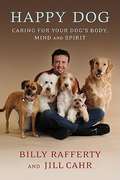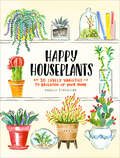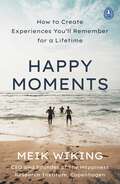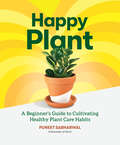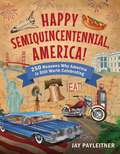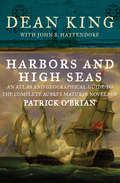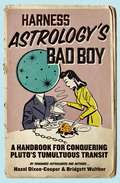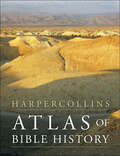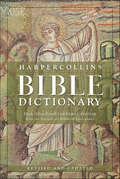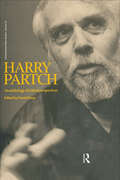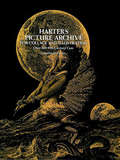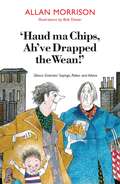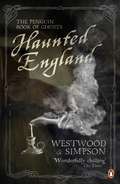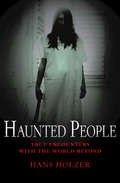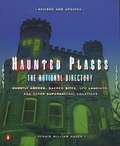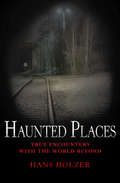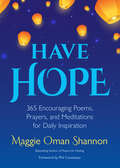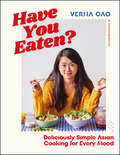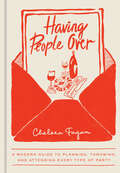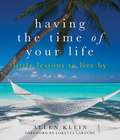- Table View
- List View
Happy Dog: Caring For Your Dog's Body, Mind and Spirit
by Billy Rafferty Jill CahrShow off your happy dog! Every Friday from September 6 - October 2, 2009 the authors will choose a photograph of a happy dog to post on their website and treat the winner to a fabulous prize package. See www.happydogland.com/contest for details.A well cared-for dog is a happy dog. This book goes beyond grooming to explain how the personal touch can make a big difference in a pet's physical and emotional health. From basic first aid to understanding the complete needs of a canine companion, Happy Dog shows pet owners step-bystep how to: * Monitor a pet's health * Set up a stellar home grooming station * Brush, bathe, and dry a panting pal * Dog-proof the home and travel right With his extensive expertise, Billy Rafferty includes invaluable and exclusive features, such as: * A yearly grooming calendar * Appraisals of products and tools on the market * Safety and emergency preparedness tips * Pet nutrition, exercise and play rules * Illustrations and photos throughout--including special appearances by celebrity dogs With the expert knowledge condensed in these pages, reading Happy Dog could be the best thing a dog owner ever does for a furry best friend.
Happy Houseplants: 30 Lovely Varieties to Brighten Up Your Home
by Angela StaehlingEnhance your home décor with this guide to choosing and caring for indoor plants, with information on thirty common, easy-to-grow varieties. For anyone who has longed for a garden of their own—whether a city dweller or one with less-than-green thumbs—this is a handy little guide to growing and maintaining houseplants. Cheerful and informative, Happy Houseplants will guide any budding indoor botanist through a bevy of topics, from soil and water to light and fertilizer. With beautiful illustrations accompanying thirty different profiles of plants, from the easygoing Air Plant to the striking Zebra Cactus, this nifty book is the perfect gift for anyone looking to bring a piece of the outdoors inside.
Happy Moments: How to Create Experiences You’ll Remember for a Lifetime
by Meik Wiking'Meik's new book will change the way you think' Dr Rangan Chatterjee___________________________________________________________________________From the same author that brought us The Little Book of Hygge, this book reveals the secret to filling your life with happy moments, and how to remember them for ever.Happy memories don't have to be reserved for big life events. Drawing on global surveys, behavioural science experiments and data gathered by The Happiness Research Institute in Copenhagen, Meik is here to show how we can we can turn ordinary experiences into something extraordinary.Whether it's eating dinner at the table rather than in front of the TV, exploring a new part of your neighbourhood, or planning how you're going to celebrate your small wins, this book will help you find the magic in the every day, and create memories you will cherish forever.PRE-ORDER THE HYGGE HOME, THE NEW BOOK FROM THE AUTHOR OF THE LITTLE BOOK OF HYGGE
Happy Plant: A Beginner's Guide to Cultivating Healthy Plant Care Habits
by Puneet SabharwalForeword by Morgan Doane and Erin Harding, co-authors of How to Raise a Plant and Make it Love You Back and co-founders of @HouseplantClub.This comprehensive visual guide to houseplant care is packed with illustrations and hand drawings, color photography, accessible infographics, and advice for first-time and experienced plant parents alike.Build confidence in tending indoor plants through this guide to basic plant care, all while learning about the history of houseplants, how they communicate, and sustainable ways to troubleshoot houseplant parenting issues. Whether you're afraid to bring home a plant or have a healthy row of potted green pals on your windowsill, this book will walk you through the trials, errors, and joys of plant care.Perfect for those who are new to gardening or who want to learn more about how plants enrich our lives, this how-to guide from Puneet Sabharwal, cofounder of popular plant subscription company Horti, is a verdant treasure trove of information on how to raise your very own houseplants.
Happy Semiquincentennial, America!: 250 Reasons Why America Is Still Worth Celebrating
by Jay PayleitnerIt's America's 250th birthday! Here are 250 reasons to celebrate this land of the free and the brave. Let&’s hear a round of thunderous applause for America&’s semiquincentennial! (Or maybe a reluctant and sarcastic slow clap from you cynics in the crowd.) Sure our beloved nation is far from perfect. From sea to shining sea there are still challenges to meet and opportunities we have overlooked. But hey. Look how far we&’ve come in just 250 years! We&’ve added 37 states and there are currently 130 times as many Americans as there was in 1776. Population growth is good, right? We&’ve hired 47 presidents, admittedly some better than others. And then there is corn on the cob, Route 66, Philly cheesesteaks, Wrigley Field, greasy spoon diners, SPAM. Are you smiling yet? In these pages you'll find a pinch of nostalgia, a dash of travelogue, a burst of patriotism, and even a challenge for all Americans to cherish this country and . . . maybe do better. Whether you&’re a progressive, a conservative, or refuse to be labeled, we invite you to celebrate America&’s semiquincentennial. Join us for a much-needed healthy dose of optimism, a dash of silliness, and proof positive that America is still the place you want to call home.
Haptic Communication: The Helen Keller National Center's American Edition of the Original Title Haptisk Kommunikasjon
by Hellen Keller National Center Hildebjørg Karlsen Bjørge Kathrine Goborg Rehder Magni ØveråsThanks to a new, emerging system of touch signals, people who are DeafBlind and blind now can have access to visual and environmental information at the same time as a sighted-hearing person.
Harbors and High Seas: An Atlas and Geographical Guide to the Complete Aubrey-Maturin Novels of Patrick O'Brian
by Dean King John B. HattendorfThis companion for fans of the Napoleonic sea sagas offers maps of the novels&’ streets, seas, and coasts, and much more. The tall-masted sailing ships of the early nineteenth century were the technological miracles of their day, allowing their crews to traverse the seas with greater speed than had ever been possible before. Novelist Patrick O&’Brian captured the thrill of that era with his characters Jack Aubrey and Stephen Maturin, who visited exotic locales in the service of the Royal Navy. From frigid Dieppe to balmy Batavia, they strolled the ports of the world as casually as most do the streets of their hometown. Packed with maps and illustrations from the greatest age of sail, this volume shows not just where Aubrey and Maturin went, but how they got there. An incomparable reference for devotees of O&’Brian&’s novels and anyone who has dreamed of climbing aboard a warship, Harbors and High Seas is a captivating portrait of life on the sea, when nothing stood between man and ocean but grit, daring, and a few creaking planks of wood.
Harness Astrology's Bad Boy
by Hazel Dixon-Cooper Bridgett WaltherDon't let your life be bullied by Pluto. Discover how to domesticate astrology's bad boy and master the transition into the Pluto era.Pluto, the planet of transformation, is in transit in Capricorn through 2024, awakening a tidal force of change. The last time we saw this combination, the world felt the impact in the Revolutionary War that birthed America. In this wickedly funny guidebook, world-renowned astrologers Hazel Dixon-Cooper and Cathleen Bridgett Walther are here to show you how to use this unique time to overcome fear, guilt, regret, and self-punishment, and find your place in the cosmos. Their in-your-face advice and step-by-step instructions will help you unlock the heroic part of your soul and flourish in every aspect of your life. Pluto's transit in Capricorn presents all of us with a series of cosmic wakeup calls--bringing a unique opportunity to overcome our most difficult and ingrained traits. Begin now with Harness Astrology's Bad Boy, and you will emerge this Pluto transit stronger, wiser, and more in control of your life than ever before.
HarperCollins Atlas of Bible History
by James B. PritchardAn overview of biblical people, lands, and culture. “The trove of artworks, maps, and photographs make it a pleasure just to flip the pages.” —History WireFrom the earliest evidence of humankind in Palestine to the establishment of the kingdoms of Judah and Israel, the ministry of Jesus, and the rise of the Christian Church, the richly illustrated HarperCollins Atlas of Bible History brings the Bible to life in all its geographical context.Detailed biblical references, timelines, and suggestions for further reading accompany each period of biblical history, conveying a tangible sense of the land, events, and people portrayed in the world’s most famous book. With more than 100 full-color maps, timelines, and expert explanations, this superlative reference work will enable readers to more fully appreciate and understand the Bible and its stories.The HarperCollins Atlas of Bible History features:Over 100 full-color geographical and topographical mapsThe latest archaeological information, floor plans, city plans, illustrations, and artistic recreations of ancient lifeCharts, graphs, statistics, informative sidebars, and moreDetailed biblical referencesTimelines that place each section of the Bible in its historical contextWeb site recommendations for further interactive study
HarperCollins Bible Dictionary
by Mark Allan PowellThe HarperCollins Bible Dictionary, revised and updated edition, is the most complete, up-to-date, and accessible guide for the study of the Bible available today. With more than 4,000 lively, informative, and reader-friendly entries, this essential reference book provides all the information you need to understand the Bible.Whether you are a pastor, layperson, or a student of scripture, you will find every important name, place, and subject that makes Bible study come to life. From Aaron to Zurishaddai, here are all the people, events, and ideas of biblical times. This third edition continues in the rich tradition of its predecessors but has been thoroughly updated and revised by a new editorial team under the direction of the premier international scholarly body, the Society of Biblical Literature (SBL). More than half the articles in this book are new, and several dozen charts and tables have also been added as well as updates on recent archaeological discoveries.Over 200 contributors to the HarperCollins Bible Dictionary, from a diverse group of authorities, represent an ecumenical and non-biased viewpoint of scripture from different positions—Roman Catholic, Jewish, mainline Protestant, and evangelical. Filled with explanations of biblical beliefs, language, and insights into the culture and customs of the people who lived in biblical times, this resource will help anyone interested in scripture to more fully appreciate the meaning and message of the Bible.
Harry Partch: An Anthology of Critical Perspectives (Contemporary Music Review #Vol. 19)
by David DunnThis anthology of writings about the American experimental composer Harry Partch is the most comprehensive collection of commentaries about the composer and his work ever assembled. Eleven major figures of contemporary music voice their views on Partch (1901-1974) and his radical contributions to twentieth-century music. These include composers and theorists who worked closely with him and important comments from his contemporaries and musical inheritors.
Harter's Picture Archive for Collage and Illustration
by Jim HarterMen in strange flying machines ... Mysterious veiled women ... Exotic animals, birds, insects, plants ... Eerie faces ... Wonderful technological devices ... Unusual landscapes, cityscapes, moonscapes ... Children, couples, Victorian buildings, and interiors ... Over 300 authentic and strikingly visual nineteenth-century engravings selected from rare periodicals, books, and catalogs, dating mostly from 1870 to 1900, and valuable for collagists, commercial and graphic artists, designers, illustrators, and others.These rare pictures, both real and imagined, of relics, rituals, people, animals, and geometric shapes and designs provide much-needed material for collage and illustrations -- material of the highest quality that is difficult if not impossible to find elsewhere. There are 25 full-page scenes of historic, natural, and city vistas that are ideally suited as background for collages and other projects. All of the pictures are sharply defined and clearly printed on one side of each page to allow for optimal use of their lines and textures and to eliminate the possibility of "show-through."The illustrations were chosen by the well-known collagist Jim Harter, whose work has appeared in TheNew York Times, New York magazine, and other publications. Mr. Harter's artistry is evident in his selection of images that -- besides being useful as decorative or illustrative elements -- have a strong visual impact and symbolic potential. Line engravings offer unique textural qualities, and as Mr. Harter writes, they "have a dream-like quality that other material cannot duplicate." Mr. Harter's introduction gives a brief history of collage as well as instructions on techniques and materials and an overview of his own perspective on the art. To illustrate the various ways these nineteenth-century cuts can be used, six collages composed entirely of images from this book are included.
Hash Cakes: Space cakes, pot brownies and other tasty cannabis creations
by Dane NoonGive yourself the munchies (in every sense) with this ultimate guide to snacks for stoners. Packed with truly delicious recipes for easy-to-make cannabis creations, this is a fun, easy way to whip up a truly relaxing snack or those perfect house-party hash cakes. Cooking with cannabis is the easiest way to enjoy the herb without the hassle of all that paraphernalia and the health risks of smoking. Studies have shown that tar from joints can contain up to 50% more carcinogens and carbon monoxide than regular cigarettes, making this the perfect gift for anyone who wants to avoid the respiratory problems and stigma of smoking, or plain can't roll a spliff. Plus, with a section on the different forms that cannabis comes in, and how you can adapt your recipes to suit them, you can be sure to never overdo the dope. This no-nonsense, no-fuss cookbook ensures that even a half-baked chef can turn out perfect results every time.
Haud Ma Chips, Ah've Drapped the Wean!: Glesca Grannies' Sayings, Patter and Advice
by Bob Dewar Allan MorrisonAn hilarious and often wise collection of Scots saying straight from the mouths of the Grannies of Glasgow. With each snippet accompanied by a straightforward English translation, this is your introduction to the unique wisdom of the 'Glesca Granny'.
Haunted England: The Penguin Book of Ghosts
by Jennifer WestwoodWatch out for a ghostly ship and its spectral crew off the coast of CornwallListen for the unearthly tread and rustling silk dress of Darlington's Lady JarrattShiver at the malevolent apparition of 50 Berkeley Square that no-one survives seeing Beware the black dog of Shap Fell: a sighting warns of fatal accidents England's past echoes with stories of unquiet spirits and hauntings, of headless highwaymen and grey ladies, indelible bloodstains and ghastly premonitions. Here, county by county, are the nation's most fascinating supernatural tales and bone-chilling legends: from a ghostly army marching across Cumbria to the vanishing hitchhiker of Bluebell Hill, from the gruesome Man-Monkey of Shropshire to the phantom congregation who gather for a 'Sermon of the Dead' ...
Haunted People: True Encounters With The World Beyond (True Encounters with the World Beyond #5)
by Hans HolzerParanormal expert Hans Holzer investigates the strangest cases of possession—the rare and disturbing instances when a ghost attaches itself to a living person Professor Hans Holzer explores the chilling phenomenon of possession: when a ghost is not yet ready to pass on to the next stage and thus inhabits a living person. These cases are not nearly as common as haunted houses or places, but do occur. In Haunted People, Holzer investigates chilling reports of ghosts who have attached themselves to living hosts.
Haunted Places
by Hauck Dennis WilliamIn almost any town in America, or within a short drive, there are places where strange things happen. . . Hundreds of houses, hotels, cemetaries, schools, and museums are believed to have resident ghosts and poltergeists. Many campgrounds and parks are on land considered sacred or inhabited by spirits. Some areas are thought to generate vortexes of psychic energy, while others are known for frequent sightings of Bigfoot creatures or UFOs. From Maine to Hawaii, this fascinating book leads you to more than 2,000 haunted places, many of them open to the public, in all fifty states. You'll find ghosts famous and obscure from the lawless days of the Gold Rush, from the Revolutionary War, the Civil War, and the Roaring Twenties--even ghosts who first appeared in the 1990s. Entries are organized alphabetically by state and are referenced to an extensive bibliography of sources. Addresses, phone numbers, and travel directions are provided for all sites. Haunted Places is a most unusual travel guide for the tourist who has seen it all and an indispensable casebook for all those interested in the paranormal.
Haunted Places: True Encounters With The World Beyond (True Encounters with the World Beyond #6)
by Hans HolzerJoin paranormal expert and ghost hunter Hans Holzer as he investigates the most famous haunted locations around the worldGhosts have been known to haunt not only houses but other locations as well—such as dark forests, trains, ships, and even airplanes. Professor Hans Holzer looks at several of the most menacing of these cases, from the ghost bride of Nob Hill in San Francisco to the &“gray man&” of Pawley&’s Island in South Carolina and the haunted organ at Yale University in New Haven, Connecticut.
Have Hope: 365 Encouraging Poems, Prayers, and Meditations for Daily Inspiration
by Maggie Oman ShannonFind Hope Even in the Darkest Times with This Collection of Poems, Prayers, and Inspirational Quotes“Have Hope is an essential companion to turn despair into hope, and put belief into action toward creating a better future.” —Becca Anderson, author of The Book of Awesome Women#1 New Release in Spiritual MeditationsA life-affirming collection of 365 poems, prayers, and meditations that can support you through any trial and that you can carry with you wherever you go.Inspirational words to help you navigate life's challenges. Reverend Maggie Oman Shannon, M.A., spiritual leader of Unity Spiritual Center of San Francisco, is the author of nine previous books that explore cross-cultural forms of prayer and spiritual practice. Now, for those of us dealing with events such as the global pandemic and with personal battles of life comes her latest book, Have Hope.Daily affirmations for every need.Have Hope offers you daily affirmations and a hope-filled moment from history for each day. Now more than ever, we need inspirational words that can help create moments of peace. Through the everyday stress of your life, Have Hope is the perfect collection of prayers, meditations, and inspirational quotes that you can turn.In Have Hope, Reverend Maggie Oman Shannon provides:A collection of 365 daily affirmations for every occasionWisdom from every era and every major faith traditionWays to find hope through daily inspirational words and insightful meditationsIf you enjoyed books like Prayers for Calm, I Really Needed This Today, or This Just Speaks to Me, then you’ll love Have Hope. Also, you will want to read and own Maggie Oman Shannon’s Prayers for Healing.
Have You Eaten?: Deliciously Simple Asian Cooking for Every Mood
by Verna GaoA beautifully personal cookbook of more than 70 easy and inspiring Chinese and East Asian recipes for every occasion.Verna Gao is throwing a Chinese dumpling party and everyone is invited—so roll out the dough and learn to pleat like a Hangzhou grandma! The Hungry Banana Cookbook brings together more than 70 of Verna&’s all-time favorite Asian-inspired recipes. Each dish is simple to make and sumptuous to eat, with something for every mood or occasion—whether you want to be slurping spring onion noodles in a matter of minutes, sinking into a comforting bowl of congee, or sharing a round of vegan baos with friends. More than just a compendium of recipes, this is a personal journey back in time, through words, memories, and photographs, to the people and places that inspired these dishes—from memories of a Shanghai childhood spent with mom and grandma in the kitchen, to impromptu &“real Chinese&” cooking lessons with college friends and backpacking around the street food hotspots of East Asia.Super fresh, vegan adaptable, and full of punchy flavors, Verna&’s unfussy recipes make Chinese home cooking accessible to everyone.
Having People Over: A Modern Guide to Planning, Throwing, and Attending Every Type of Party
by Chelsea FaganBecome the perfect host and learn how to foster community as an adult with this modern guide to hosting every type of gathering.In a world that often feels disconnected and transactional, there's nothing more radically hospitable than welcoming people into your space, your table, and your life.In this accessible, inviting book on hosting and entertaining, author, CEO, and internet big sister Chelsea Fagan guides readers on creating moments worth staying in for. From designing the right space, to crafting a menu that won&’t keep you in the kitchen all night, to revitalizing the lost art of cultivating grown-up communities, this book will make you the perfect host at every budget. Having People Over includes guides for:• Curating a space optimized for entertaining, so people can drop by without it sending you into a tailspin.• A brief history of the cocktail hour—and its imagined future—including recipes with and without spirits. • The 101 tutorial for all things dinner parties: inviting guests, setting the table, planning a menu, creating a mood board, and actually enjoying the evening yourself.• Facilitating a (platonic) adult sleepover—and why you definitely should!• How to be good guest wherever you go, from when to show up, to what to bring, to what absolutely not to do.With chic, stylized photography and charming, illustrative line drawings throughout—providing everything from sample tablescapes to charcuterie board maps—and plenty of actual recipes for your next gathering, Having People Over will transform your relationship to entertaining, one apéritif at a time.
Having the Time of Your Life
by Loretta Laroche Allen KleinThe big questions come to us at different times. Whether just starting college, about to have a first child, or considering a new house or job, at some point we've all asked, "Why am I here? What is life? What am I doing?" In Having the Time of Your Life, Allen Klein helps us come to terms with these questions and have a few laughs long the way. He has collected 500 inspiring and uplifting quotations on the endlessly fascinating subject of life itself. From Lily Tomlin to Abraham Lincoln, the people quoted in this book have perspective to offer everyone, no matter which of life's many roads they may be traversing. Don't let the heavy questions weigh you down! With selections covering topics ranging from finding forgiveness to making music, this book offers a healthy dose of the motivation and levity we all need.
Having the Time of Your Life: Little Lessons to Live By
by Allen KleinThe big questions come to us at different times. Whether just starting college, about to have a first child, or considering a new house or job, at some point we've all asked, "Why am I here? What is life? What am I doing?" In Having the Time of Your Life, Allen Klein helps us come to terms with these questions and have a few laughs long the way. He has collected 500 inspiring and uplifting quotations on the endlessly fascinating subject of life itself. From Lily Tomlin to Abraham Lincoln, the people quoted in this book have perspective to offer everyone, no matter which of life's many roads they may be traversing. Don't let the heavy questions weigh you down! With selections covering topics ranging from finding forgiveness to making music, this book offers a healthy dose of the motivation and levity we all need.
Hawaiian Legends of Volcanoes
by W. D. WesterveltInterspersed with legends of the fire goddess Pele, the lightning goddess Hiiaka, and others, are nuggets of related geological and historical information. First published in 1916, this book has a four-page appendix and notes on Polynesian language.
